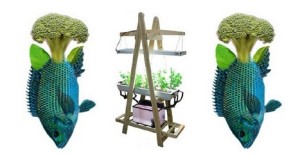Aquaponics is a method by which you grow plants and nurture aquatic animals together in a system that recirculates the nutrients produced, to the benefit of both plants and animals. The aquaponics approach is gaining in popularity as a sustainable gardening method.

The idea take conventional aquaculture, (raising aquatic animals such as snails, fish, crayfish or prawns in tanks), with hydroponics (cultivating plants in water) in a symbiotic environment. In normal aquaculture, excretions from the animals being raised can accumulate in the water, increasing toxicity. In an aquaponic system, water from an aquaculture system is fed to a hydroponic system where the by-products are broken down by nitrogen-fixing bacteria into nitrates and nitrites, which are utilized by the plants as nutrients. The water is then recirculated back to the aquaculture system.
Tilapia is the most common fish for Aquaponics due to its rapid growth, large size, great taste, hardiness. Talapis can adapt to most any condition with the exception of water temperature. Tilapia prefer warm water – at least 75 degrees Fahrenheit. It takes about 9 months for our Tilapia to grow to a harvestable size, about 1.5 pounds. Tilapia has a varied diet including duckweed, ground-up greens from a greenhouse, worms, and Tilapia love to eat algae from the side of the tank.As existing hydroponic and aquaculture farming techniques form the basis for all aquaponics systems, the size, complexity, and types of foods grown in an aquaponics system can vary as much as any system found in either distinct farming discipline.


